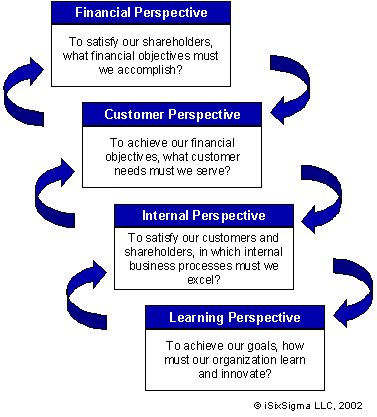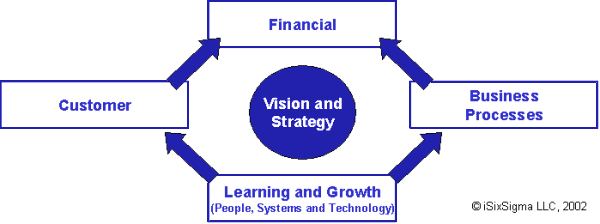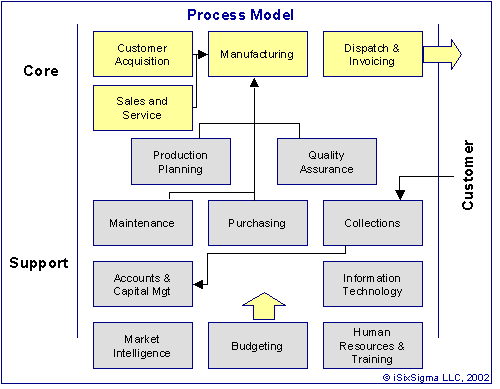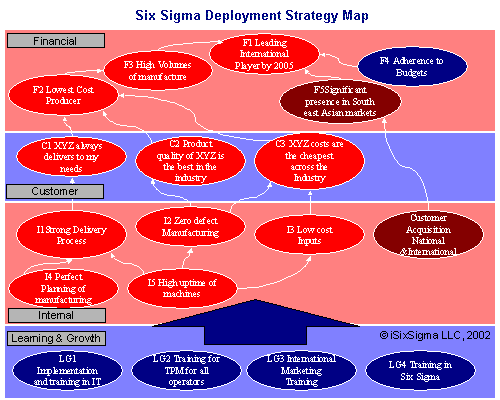
All Six Sigma proponents agree to the fact that the key to Six Sigma improvement success is the building up of an effective infrastucture. An effective infrastructure lays the foundation for the success of the organization in its implementation of Six Sigma. It is a known fact today that the success of Six Sigma lays on the projects selected and their link to the strategy of their organization. There have been enough publications on the selection of projects and the filters to be used for the prioritization of projects, however there are not enough details available on the building the key infrastructure for the deployment of Six Sigma.
When we discuss the building up of an implementation structure what we are embarking on is a project in itself, which follows the DMAIC (Define, Measure, Analyze, Improve, Control) methodology:
D: Define the strategic direction of the organization
M: Set measures for the strategic objectives of the organization
A: On a continual basis collect data on the measures set and analyse using Six Sigma tools and techniques
I: Identify the opportunities for improvement and convert them to Six Sigma projects for improvement
C: Set up a management control action of continuous reviews on the improvements made on Six Sigma projects
The objectives of the Define and Measure phase of this project are defined as below:
- Building up a set of metrics for the organization that give definition to the organizations vision
- Metrics that are integrated with the strategic direction and objectives of the organization
- Metrics that align people and work with their strategic objectives
- Metrics that serve as effective means of communication for the organization both horizontally and vertically.
- Metrics that provide insight needed for making decisions, setting direction and correcting course.
- Metrics which will serve as a continuous source for identifying gaps in the organization and plugging them with Six Sigma pProjects
The problem most organizations face in the phases of Define and Measure is how to build such an organizational dashboard, which will help achieve the objectives cited above.
First Step
The first step an organization needs to embark on is conducting a self-assessment based on proven assessment models like the Malcolm Baldrige which will help the organization in understanding its “as is” state more clearly and help identify the various opportunities for improvement. The organizations could use the checklist type of approach in conjunction with interviews for identifying the gaps in approach-deployment-results. Once the assessment of the organization is completed the findings need to be shared with the top management and the employees. This step is extremely crucial as this is what binds the organization together and helps create the cultural change needed aspect within the organization combined with the need for Six Sigma.
Second Step
Once the first step is conducted the organization is now clear about its current strategies for growth and customer statisfaction. Based on the assessment conducted the organization can re-evaluate all its strategies and strategic objectives. New strategic objectives can now be identified.
Third Step
Most organizations after having articulated and identified their various objectives are unable to communicate the strategies of the organization. One of the most effective methods for communicating the strategy of the organization is building a strategy map encompassing the now widely adopted Kaplan and Norton’s Balanced score card spanning the four perspectives. Answering the questions related to the perspectives helps understand the strategy better and also build a good strategy map. The strategy map helps provide the vital cause and effect linkages in an organization and helps link the Business processes to the strategic destination of the organization. Before attempting to build the map it is essential for the organization to identify all its core processes and support processes as they help in completing the strategy map.

The Balanced score card perspectives help an organization to integrate and operationalise the organizations strategy.

- Figure 2: Vision and Strategy
As an example for the application for the application of the method consider a hypothetical case mentioned below. This case utilizes the frequently used catapult in the Six Sigma Black Belt training and explains the concept.
XYZ is a company that is newly set up. It is in the business of delivering thrown balls to customer specifications. It has a vision of being a leading international player in the business of thrown balls by the year 2005. It hopes to achieve this through high volumes and low cost by being the lowest cost producer. The company values its customers very strongly and believes in customer retention as its strength. In order to meet this vision the company CEO has ordered the latest state of the art machinery – the Catapult – for a cost of ten million dollars.
The business of thrown balls is a relatively new business. In prior years, potential customers of this business had their own machinery and set-ups to meet their internal requirements. Today, where organizations are focusing on their core activities, various users of thrown balls are contemplating outsourcing this activity, making this business a very viable potentially high earning business.
XYZ has to market their product from scratch where they have to identify the markets and generate the marketing demands. International threats from Chinese products is very high. The Chinese products are known to be supplied at a very low cost making them potentially high threat to the industry. Apart from the Chinese threat there are four other Indian competitors.
The key requirements of customers are the consistency in the distance the ball is thrown from the base of the catapult. Variation from the center of the base is also critical, however, the customer might accept products offered with variation beyond specifications subject to customers approval. Delivery on time is one of the key requirements of the customer.
To service the customers properly the CEO has decided to operate through three sales and marketing outlets and two manufacturing units strategically located.
The spares of the machinery imported are not available freely in India. The organization cannot afford downtime of machines and has taken necessary steps to ensure that the machines are in the best of shape.
The management has decided that it needs to keep a control on the costs while developing business. The main raw material for the product is the balls and they are available freely in India. The marketing department has just received a hot inquiry from a potential client. This customer is one of the largest potential customers in the market.
The customer needs are that he wants balls to be delivered at 75+- 3 inch from the base of the catapult. The ball delivered to be +-2 inch from the center of the base (axial requirement). The customer needs 50 balls delivered within 10 miniutes. For balls that do not meet the requirement of +-2 axially but are in the +- 3-inch specification, the customer will buy the material at a 10 percent discount. Selling price of each correct ball delivered is $1000. Despite stiff competition from the Chinese on the price front, your marketing manager has been able to get this pilot order.
Raw material price for the ball is $500.
Roadmap Continued
It is very difficult to articulate the strategies of the organization in this given scenario. Withith help of the Kaplan and Norton score card philosophy presented earlier, it is fairly easy and at the same time enlightening for the organization to build the business process model and then continue on the strategy map of the organization. Below is shown a possible process model for the organization depicted earlier.

A possible strategy map for the organization depicted is shown below. Articulation of the strategy in a map as shown below helps clarify the strategic objectives of the organization and serves as an excellent communication tool to all in the organization so that there is a common understanding and alignment within the organization.

Fourth Step
Once the strategy map is completed the organization can now start looking at each of the objectives in the shareholders and customer perspectives, and identify various measures that will help in achieving the strategy. When identifying measures, organizations must try to focus on what needs to be measured to achieve the strategy rather than plug existing measures into the objectives. Measures selected need to have a right balance between Lead and Lag. Lag measures are metrics that are obtained after the event is over, whereas Lead measures are metrics that tend to measure the drivers that help reach the destination.
Identify the various benchmarks in the Industry for the various measures selected. Based on the current level of performance decide on targets for the organization. Below is an example of metrics for the strategic objective “XYZ always delivers to my needs.”

Fifth Step
For the key core and support processes, develop high level process maps based on the concept of SIPOC (Supplier, Input, Process, Output, Customer). The process model developed earlier serves as an excellent resource. Identify key metrics for each of these processes. Return back to the strategy map developed and for each of the process strategic objectives select appropriate measures linking both the customer perspective measures identified in step four to the process perspective measures identified. Select process strategic objectives measures that reflect the customer’s viewpoint. Conventional Six Sigma metrics like DPMO, sigma level or rolled throughput yield may be appropriate. Once the measures for the process strategic objectives are identified, identify measures for the learning and growth perspectives. As discussed earlier, remember to balance in lead and lag measures and identify suitable benchmarks for these measures.
Sixth Step
Deploy the organizational score card at the departmental level. During the deployment of the scorecard break up the measures as applicable to the department. This would ensure that the organization has appropriate metrics at all levels and and that they are integrated both vertically and horizontally within the organization.
Seventh Step
Once the organization is hardwired with the metrics, start collecting data on the metrics and identify on a continual basis various gaps in the organization. The champions training received by the senior management will be extremely useful in this phase as the champions will analyse data based on the type of cause (special or common) and then would work on whether a potential project is identified or not.
An implementation structure of Six Sigma modeled on this method is a sure fire method for ensuring maximum benefits from the Six Sigma strategy deployed within the organization.
“When you can measure what you are speaking about and express it in numbers you know something about it, but when you cannot measure it, when you cannot express it in numbers, your knowledge is of a meagre and unsatisfactory kind.” – Lord Kelvin